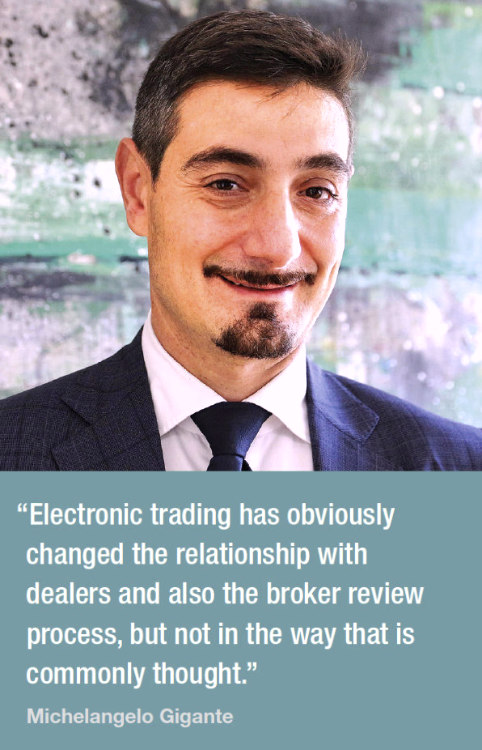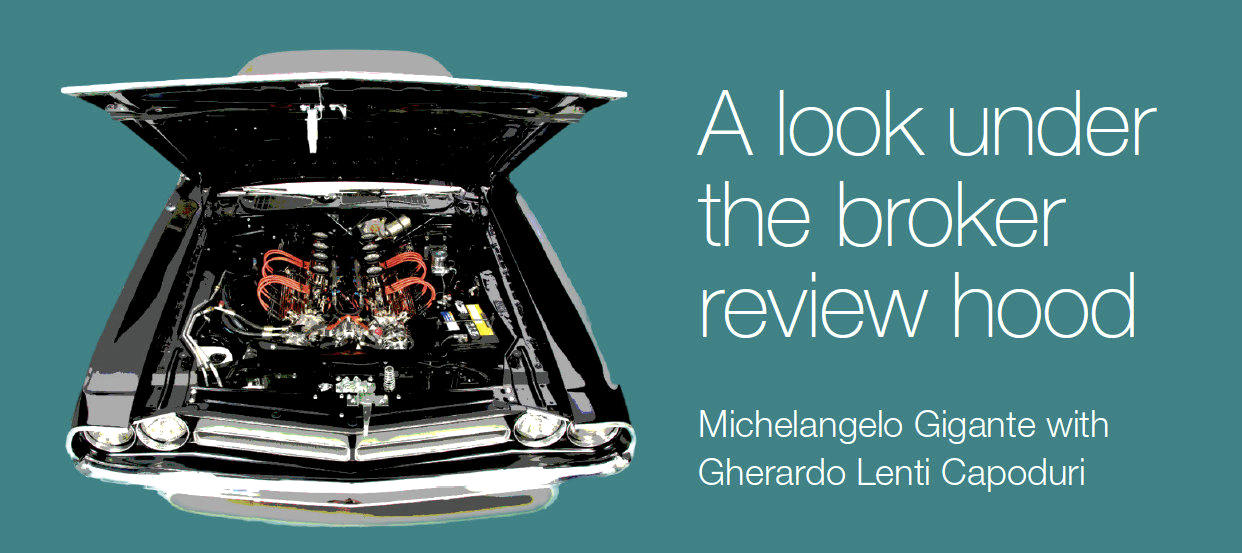In this Agency Broker Hub column, Michelangelo Gigante, head of Execution Desk at Eurizon Capital SGR and Gherardo Lenti Capoduri, head of Market Hub, Intesa Sanpaolo discuss the evolution of the broker review.
Regulatory change and technological innovation are reshaping the traditional client-sales-trader workflow and the role of financial markets participants.
The sell side are looking for new trading models to provide liquidity due to the increase of capital requirements and reduction of inventory, and the buy side are asked to play a different role in financial markets, in some cases adapting their trading capacity from pure price- taker to price-maker.
In this new scenario, broker review metrics and scoring methods are also changing as a result of the introduction of the unbundling of research and best execution provisions under MiFID II, together with the parameters needed to measure the quality of execution and the service levels provided by brokers to their clients.
 How has electronic trading and MiFID II changed broker reviews?
How has electronic trading and MiFID II changed broker reviews?
Michelangelo Gigante (MG): Electronic trading has obviously changed the relationship with dealers and also the broker review process, but not in the way that is commonly thought. Previously, salespeople had different remuneration, depending on whether the deal was voice or electronic request for quote (RFQ), and for that reason salespeople saw electronic RFQ as a nuisance, jeopardising their remuneration and the exclusive relationship with the client.
Slowly but surely, things are changing: electronic RFQ is a complementary protocol used for small quantities, or quantities that can be easily absorbed by the dealers/market, and it’s a tool used in parallel with voice trading used for large trades. And nowadays there isn’t usually a difference of compensation between the two protocols. All-to-all fixed income business is, more than in the past, a relationship business and the two protocols, electronic and voice, are both part of the discussion because both are useful in different situations.
Gherardo Lenti Capoduri (GLC): The level of automation in the trading process is helping to separate high-touch and low-touch execution and the balance between them, depending on the asset class, the type of order and the market landscape. Whereas low touch is completely managed by electronic trading, where human resources are more dedicated to the monitoring of the process and the development of new technological solutions, high touch execution (via voice/chats) now requires a greater degree of customisation to meet clients’ more sophisticated needs. This channel is now preferred for larger orders that require greater care and attention. In addition to plain execution, brokers must be able to offer a series of additional services to mitigate client operational risks and to be compliant with new regulatory requirements such as those introduced by MiFID II’s Investor Protection (primarily research unbundling and best execution).
These factors have become more and more important in recent years. As a consequence, this transformation in the role of voice and of the interactions between brokers and customers is now based on much higher quality standards, compared to the past.
What can asset managers do to show brokers their performance most effectively?
MG: Let’s start by saying that dealer performance is something to be discussed with a partnership approach and in this discussion, there will be subjective and objective terms. Transaction cost analysis (TCA) is a good starting point with which to assess dealer performance for all the trades done in competition. TCA provides some useful statistics to show to the dealer elements about its performance versus market leaders and peers such as:
• Hit ratio – in terms of volume for each business (Govies, corporates, high yield (HY), emerging markets (EM), EM local currency);
• Hit ratio – in terms of tickets for each business (Govies, corporates, EM, HY, EM local currency);
• Statistical distribution of the prices negotiated vs bid-offer prices at the moment of the trades (risk weighted);
• Quit rate – percentage of times dealers haven’t shown any price after receiving the RFQ;
• Percentage of times a dealer has changed prices in the screen after getting the RFQs;
• Percentage of times a dealer has shown prices out of market bid-offer across different sectors, curve buckets and markets.
 In terms of other topics that cannot be quantified, usually the discussion is in terms of quality of coverage. For instance, how quick is the dealer to respond to and fix problems, provide solutions, to show liquidity, to set up new accounts and so on?
In terms of other topics that cannot be quantified, usually the discussion is in terms of quality of coverage. For instance, how quick is the dealer to respond to and fix problems, provide solutions, to show liquidity, to set up new accounts and so on?
GLC: Partnership is the new paradigm in the interactions between the sell side and the buy side and this is also the new approach when discussing a broker review, by analysing all their relationships both qualitatively and quantitatively. Partnership means several things: technological support, data provision, and high-touch services, but partnership also means maintaining “the same level playing field in a relationship”. This has been a successful model during last year’s pandemic volatility, when dealing rooms had to shift towards ‘smart working’ trading models and interactions changed dramatically.
In this new paradigm, a central role is surely played by TCA services, which are now being used as a yardstick by the buy side when calculating broker review scores, by measuring operational efficiency through live data. From the sell-side perspective, the implementation of TCA services provides a competitive advantage to dealers, who can adjust order handling rules and provide relevant information to counterparties. TCA is not valid yet for every instrument asset class; for example, a recent research paper suggested replacing ‘TCA’ with ‘TQA’ (trading quality analysis) for fixed income, because it fits better with the lack of market data in bonds.
How flexible can brokers be in changing their services, and what affects that flexibility?
MG: As said, the fixed income business is a partnership, but obviously you cannot have all the dealers at the same level providing the same services (and of the same quality). The higher the volume of business done with a counterparty, the greater the collaboration you can have with that dealer. So, in this process, and generally speaking when you pave the way for a better co-operation, it is necessary to handle the expectations and be coherent within the agreed terms.
GLC: Financial markets are changing very quickly and, in this environment, there is not a one-size solution that fits any situation. Standardisation and customisation should be pursued by the broker systems and services innovation, depending to a large extent on the type of business, the volumes traded and the degree of partnership, in order to guarantee a higher level of freedom as well as the possibility of integrating with new protocols and new electronic services.
Do you see this as a collaborative process, and what will increase the level of collaboration in the future?
MG: It’s naturally a collaborative process, but at the same time it’s something that can’t be equal with all the counterparts, so that process has to follow the natural attitudes different dealers have in different businesses. That’s to take the most from each dealer and to not to ask for something dealers can’t deliver.
GLC: Co-operation between broker and customer only grows when both parties recognise each other’s potential, but also when both parties recognise the need for collaboration and try to improve aspects of common interest through technology and relationships. As said, this is the new role for sales, less focused on execution and more on services and partnership growth.
www.markethub-imi.intesasanpaolo.com/en
©Markets Media Europe 2021
©Markets Media Europe 2025













